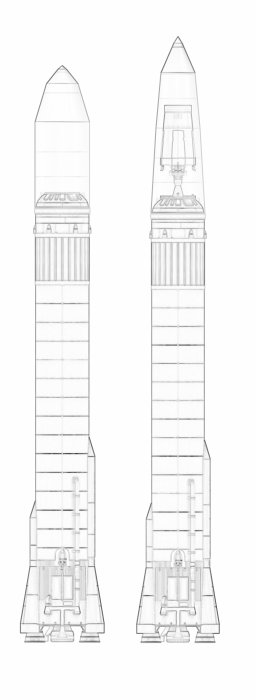Atlas - CobaltWolf/Bluedog-Design-Bureau GitHub Wiki
Atlas stage and a half designs (Bossart)
General rule for staging Atlas 1.5 stage rockets: Jettison the booster stage at 2 1/2 to 3 Gs. This should occur with around 30 seconds of fuel remaining. With the booster engines gone burn time will extend to about 2 minutes and the sustainer will be pushing you at about 1 G.
Construction

All Atlas D derived (stage and a half) designs are built from a common set of parts. The large fuel tank is the base for all of the versions. Attached to the bottom of it is the adapter tank with the single sustainer engine, and the booster fairing with twin booster engines. The verniers go on the flat spot on side of the tank.
On top of the Base goes various combinations of Medium, Small, and Tapered tanks. The combinations to use for the most prolific Atlas launchers are listed below, organized by engine type.
There is a single sustainer engine, and two upgrades to the booster engines representing the LR79-5, LR79-7 and RS56-OBA. Starting with Atlas III the stage and a half section is replaced by the single part RD-180 engine. The model of the RD-180 can be switched to fit either the Atlas III tank or the Atlas V CCB tank.
For second stages, Agena sees heavy use in the early days, while Centaur is continuously upgraded alongside Atlas. Atlas-Centaur is a capable platform for moderate geostationary and interplanetary payloads.
First Generation (LR79-5)
LV3-A Construction: Base Medium Tapered Agena A, B, or D.
LV3-B Construction: B M T Mercury Capsule
LV3-C Construction: B M M Centaur D
 LV3-A, LV3-B, and LV3-C
LV3-A, LV3-B, and LV3-C
Atlas-Vega (Vejur)
An unflown proposal, Atlas-Vega was eventually dropped in favor of Agena and Centaur. The Atlas stage is an LV3-C. Vega is the second stage using the same balloon tank construction as Atlas, powered by a Vanguard first stage engine with a large vaccuum nozzle. In the three stage variant, a JPL 6K stage taken from Juno IV (Chryslus) would be added.
Since boiloff is not an issue with these stages, this is a viable setup for deep space missions.

Use the "vega" tag to locate the Vega parts, and the "juno" tag to locate the 6K stage parts. Vega is a drop in replacement for Centaur and uses the same interstage and fairing base. The fairing base is placed under the Avionics Unit, just like Centaur. The 6K stage is just the angled tank and engine, plus 4x Micro RCS Booms.
 Atlas-Vega 2 Stage and 3 Stage
Atlas-Vega 2 Stage and 3 Stage
First Upgrade (LR79-7)
SLV3 Construction: B M T Agena D
SLV3-A Construction: B M S T Agena D
SLV3-B Construction: B M M Agena D inside fairing
SLV3-C Construction: B M M Centaur D
SLV3-D Construction: B M M Centaur D-1A
Atlas I Construction: B M M S Centaur D-1A
 SLV-3, SLV3-A, SLV3-B, SLV3-C, SLV3-D, and Atlas I
SLV-3, SLV3-A, SLV3-B, SLV3-C, SLV3-D, and Atlas I
Second Upgrade (RS56-OBA)
Vernier engines are removed to make room for strap on boosters and replaced by a single roll control thruster placed on the Centaur interstage.
Atlas II all versions Construction: B M M M Centaur II
Atlas II uses a straight fairing.
Atlas IIA uses the 2.5m fairing base.
Atlas IIAS adds 4x Castor-4 solids which are ignited in pairs. The first pair is ignited on the ground, and the second pair shortly after the first pair burns out. Then the first pair is jettisoned. After the second pair burns out and is jettisoned, the booster engines may be held on to longer than usual due to the heavier payloads.
 Atlas II and Atlas IIAS
Atlas II and Atlas IIAS
Single Stage Core (RD-180)
With two engines available throughout the burn Atlas III needs neither vernier engines or roll control thrusters.
Atlas IIIA Construction: B M M M M Centaur II
Atlas IIIB Construction: B M M M M Centaur V (Common Centaur)
 Atlas IIIA, IIIB and Atlas V
Atlas IIIA, IIIB and Atlas V